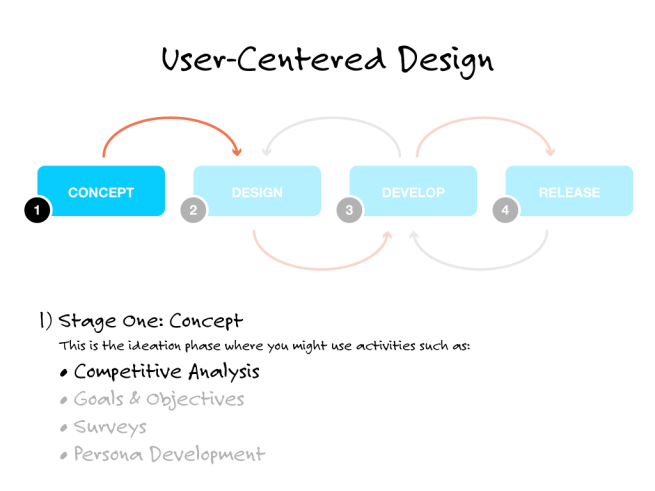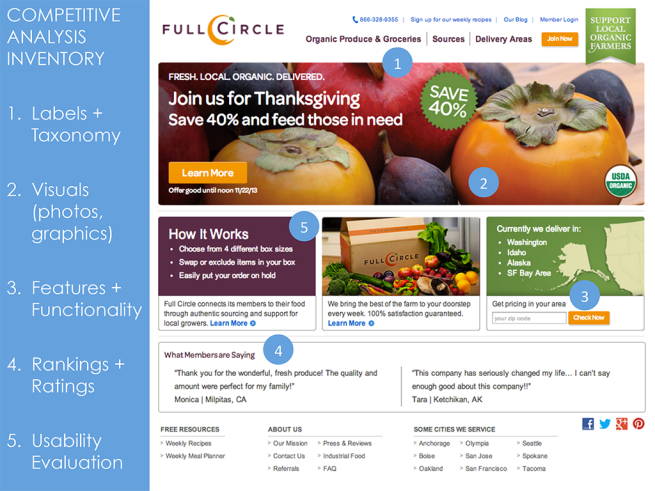WEB204 » Conducting a Competitive Analysis for Websites
Um… Hey? ‘Sup?
We all do it. We as human beings are inherently going to compare ourselves to others. We are going to see what our fellow humans are doing that people find attractive and/or unattractive. Then we might try to emulate what they are doing that others are attracted to in order to attract people to us.
What is a Competitive Analysis?
In general, Competitive Analysis is an assessment of the strengths and weaknesses of current and potential competitors. It is typically a strategy that marketing and management professionals may use to help improve their own business strategy according to their business goals.
In terms of Web Design & Development, a Competitive Analysis can provide an assessment of the User Experience strengths and weaknesses of current and potential web competitors. This analysis provides both an offensive and defensive strategic context to identify visual and interaction opportunities and best practices.
Examples:
- Website Competitive Analysis Report | Thomas & Marina
- Project Plan for Doebay.com Website Redesign | Rebecca Destello
- Totokaelo Going Mobile | Tiffany Lin
- UX Competitive Analysis | Nicold Pittman
- Competitive Analysis Slideshow | Johann Flores
- Competitive Analysis Example | Amelia Bauerly
According to Rick Allen, “A competitive analysis of web content is an assessment of competing websites based on your content goals. This could be an assessment of branding, usability, accessibility, information architecture, or any other element of your web or content strategy.”
See Also: Conducting a Competitive Analysis | MeetContent
Why Should We Conduct a Competitive Analysis?
In the world of Web Design & Development, we should continually analyze our website to asses if our website content is:
- Accurate: is the information that we are providing on our website up-to-date?
- On-Brand: are the images and messages consistent with our company message?
- Useful: are the applications on our site actually being used to achieve a goal?
- Findable: can our users find the information that they are seeking?
- Usable: is our website easy to use from a user perspective?
According to Jason Withrow, “The primary benefits of any competitive analysis are a better understanding of 1) what your competitors are doing, 2) what they are offering to customers, and 3) how to maintain your competitive advantage.”
See Also: Competitive Analysis: Understanding the Market Context | Boxes & Arrows
According to Thomas Myer, “A good competitive analysis not only produces usability metrics but also aids decision makers in their strategic goal-setting and planning. Done right, a good competitive analysis can steer a Web development project in the right direction.”
See Also: How to conduct a Website Competitive Analysis | IBM
According to Frances Miller, “Competitor reviews are most valuable when they focus on identifying gaps and opportunities for differentiation. They ask the question, “What does this website, application, or product offer that fills an important gap in the marketplace?” A UX expert can then design an experience that will bring this differentiator to life for the user.”
See Also: UX Reviews: Which one? How long? | UX Magazine
Therefore, we should be able to use a competitive analysis to:
- Evaluate what competitors are offering (or not)
- Inform preliminary UI designs
- Leverage helpful features
- Avoid functionality that is not useful
- Consider design patterns and trends
When Should We Conduct a Competitive Analysis?
A Competitive Analysis in typically gets performed during the concept stage when designing a new website or during a re-design of the current website.
How Do We Conduct a Competitive Analysis?
Because a Competitive Analysis is a methodology for conducting research and gathering data, we need to have a plan for conducting the study as well as gathering and reporting the data.
1) Objectives for Analysis
The first thing to consider, is what are our objectives for conducting a competitive analysis.
Some objectives may be to:
- Gather data to inform our redesign decisions
- Identify frustrations users might face
- Identify common elements to adopt or discard
2) Questions to be Answered by Analysis
Most research is lead by a desire to answer a question or test a hypothesis.
Example: Research Plan: Understanding the Effect of “Writing for the Web” on Comprehension and Retention Rates | Mike Sinkula
Some questions that you may seek answers for may be:
- How fast do pages load?
- What is the message they are conveying?
- What is the overall feel?
- Do they have the appropriate features? What are they?
3) Assesment Criteria of Analysis
The second thing to we need to consider is what assessment criteria is this study going to concentrate on.
Some assessment criteria we might concentrate on might be:
- Labels & Taxonomy
- Visuals (photos, graphics)
- Features & Functionality
- Ratings (User Feedback)
- Usability Evaluation
4) Findings & Results of the Analysis
Once we have figured out the direction of the study, we need to conduct the study and report our findings in a clear manner.
According to Martyn Shuttleworth, “The results section is not for interpreting the results in any way; that belongs strictly in the discussion section. You should aim to narrate your findings without trying to interpret or evaluate them, other than to provide a link to the discussion section.”
See Also: Writing a Results Section | Explorable
For a Competitive Analysis, you may use screenshots to aid you in discussing your findings.
Example: Project Plan for Doebay.com Website Redesign (pp.7-14) | Rebecca Destello
5) Recommendations
Once you and your team have presented your findings, you may or may not need to create a list of recommendations.
Example: Design Recommendations for SugarSync | Mike Sinkula, Christina Ntouniaoglou, Shubha Sastry, Ruby Kuo & Jake Sparling
This portion of the Premium Design Works website is written by Mike Sinkula for the Web Design & Development students at Seattle Central College and the Human Centered Design & Engineering students at the University of Washington.














1 Comment:
Trackbacks:
[…] Lecture for the week is here… […]